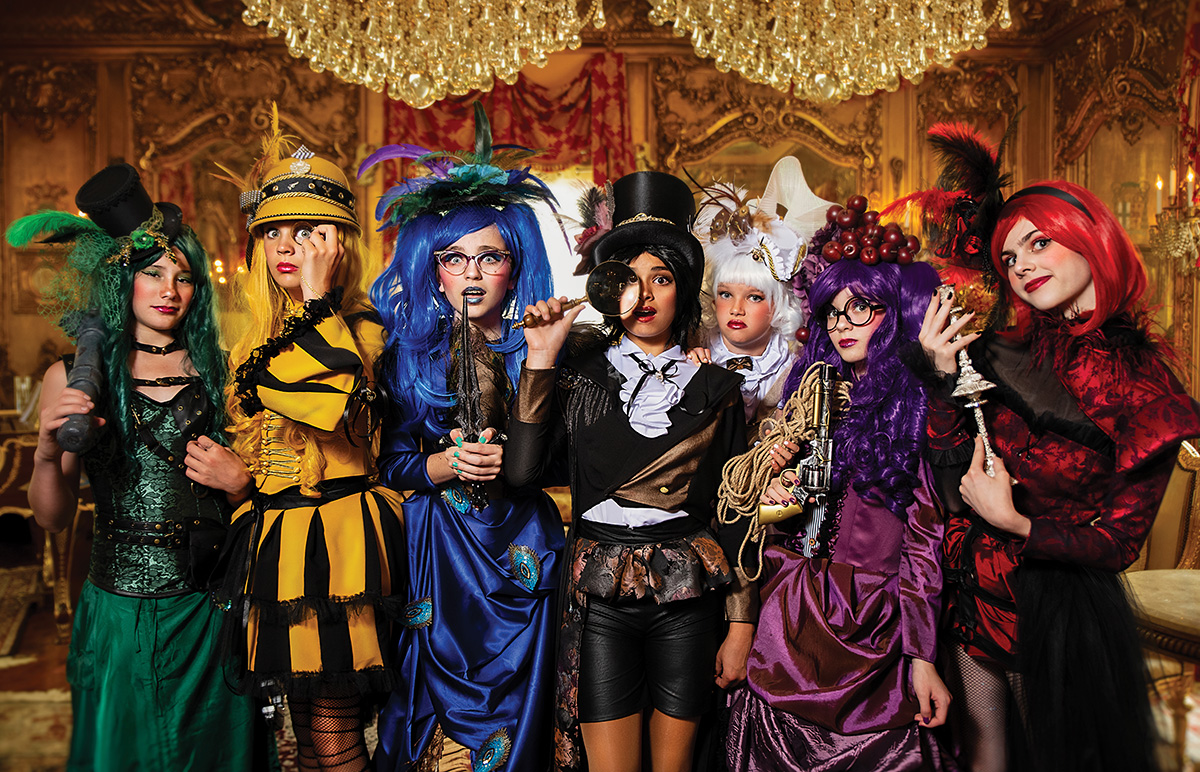Tara Mapes has never been interested in doing traditional photography. Her inspirations trend toward ornate, richly imagined scenes that evoke childhood memories and reinterpretations of fantastic worlds. And that’s what she creates, not as a whimsical novelty but as the focus of her photography for a variety of commercial, private, and educational outlets. And people can’t get enough.
Mapes began her photography journey doing landscapes and transitioned into themed sessions as an offshoot of her educational offerings. She’d been doing tutorials and began to stage themed sessions as case studies for the tutorials. These sessions featured intricate costumes and couture outfits, which caught the eye of several fashion designers who asked Mapes to create similarly staged scenarios featuring their products. This rise of commercial work led to another business line doing a limited number of themed private portraits.
“When it comes to the themed shoots, I hate to say that it just happened, but it did,” says Mapes. “It was a slow process of doing what I love to do and never doing what I don’t want to do. Over time, it developed into the work I do full time today.”

CREATION
Every themed session begins with a story. For commercial assignments, Mapes originates the concepts, then collaborates with clients to fine-tune the details so that everything reinforces the brand. It’s not a creative-on-demand process; Mapes builds a storyline around the product she’ll be photographing, fitting clients’ ideas into what she creates.
This process helps Mapes tap into her inspiration. “You can’t force it,” she says. “I believe you need to create for yourself. That’s when you learn the most, that’s how you perfect your process, and that’s how you develop a look that people recognize. There’s an authentic part of me in everything I do, and that has an appeal to my clients because it’s unique.”
Often, this process begins with informal brainstorming. Mapes may text herself an idea or jot down some inspirations in a Word document. Then she starts compiling screenshots to build the story, piecing together outfits and props that work with the theme and adding details bit by bit. As she progresses, she picks up the relevant items and builds out the scene, acting on the inspirations that go into the story. She typically builds each new scene from scratch, reusing an element only if a client asks for it specifically.
This process has led to a variety of creative takes on familiar themes, such as a steampunk rendition of the Clue game, princesses presented in ’80s style, and a dystopian “Alice Forgotten” story featuring secondary and “forgotten” characters from “Alice in Wonderland.” “In my mind, I’m creating a story from childhood inspiration,” Mapes says. “I want the viewer to have fun when they’re looking at the images.”

COMMUNICATION
Throughout the process and particularly in the beginning, Mapes brings in clients to get them excited and secure their buy-in. She doesn’t typically get pushback from clients about her concepts, she says, because of the open communication they’ve had throughout the process. “I ask them up front to tell me what they prefer and don’t prefer, and I let them know what I’m thinking for the project,” she says. “I lay out everything in the beginning—details, props, and accessories—and that communication is essential for getting everyone behind the project.”
This is the time, says Mapes, to explain the process and give clients an opportunity to register reservations or objections before she goes too far down a creative path. She also gets a sense of how much or how little the client wants to be involved in the production. She has these conversations by phone or in person to ensure a full exchange of ideas and then follows up with an email summarizing the conversation so there’s a written record of the agreed-upon details.
Mapes notes that, in the rare instance of a disconnect, it’s important to discuss the issue with the client and provide options for moving ahead: “Admit when you’ve made a mistake or there’s been a miscue, but offer a solution. Anyone can admit there’s a problem, but it takes something above to create a solution. That’s what clients ultimately want. They want their issues considered and addressed.”

COLLABORATION
Collaborating with clients is a balancing act, so Mapes maintains control of her essential processes by identifying areas where clients can be involved without muddying the creative waters. For example, she invites feedback on locations and props but typically does not allow clients to select models. “I allow partial control over parts of the process, but I have learned not to allow complete control,” she says. “That’s fine with most clients. People want to work with me because of what I produce—that’s what they’re paying for!”
Part of Mapes’ approach to collaboration is translating excitement to the client. Clients usually seek her out because of her past work and are curious to see what she can produce for them. So, they’re already excited and seeking someone who can manage their process. That’s where Mapes sees her role as building and maintaining that excitement throughout the entire production.
“It’s important to remember that when someone comes to you as the creative professional, they are coming to you because they want your expertise,” she says. “They want your vision. That’s a great honor, and I want to reward them by bringing them along with me on the creative journey. That means communicating, sharing, getting them excited and involved to the level they want, and ultimately rewarding them with a well-produced shoot that delivers on the promises.”

EDUCATION
Every time Mapes does a themed shoot, she considers how to multipurpose it to generate varied sources of income to cover the costs of production. Creating tutorials and digital backgrounds provides additional revenue from other photographers interested in applying similar styles and techniques. Mapes also offers private portrait sittings three times a year using recently produced themes from her commercial projects. This brings her business full circle: Her work in photographic education inspired her first themed sessions, the themed sessions took off in their own right, and now they feed her education initiative.
To other photographers looking to draw their own circle of creative enterprise, Mapes recommends pursuing sources of inspiration until you figure out how to make your business work around them. The approach may buck some traditional small business development wisdom, but it ultimately leads to a career doing work that you love and for which you’re a recognized talent.
Borrowing from the late painter Bob Ross, Mapes points out that “Talent is a pursued interest,” meaning if you have any skill in something, it’s because you continually pursued something you love. “Just keep pursuing that interest,” she suggests. “That’s how you learn. You review it, you make adjustments, and you keep pursuing it. Anyone who’s ever coined something as a talent got there because they simply refused to give up.”
Jeff Kent is editor-at-large.


 View Gallery
View Gallery


